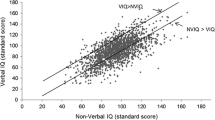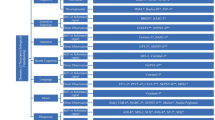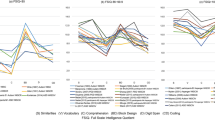Abstract
This study examined performance on the Repeatable Battery for the Assessment of Neurological Status (RBANS), a brief neuropsychological test battery of cognitive function, in participants with two levels of sub-clinical autistic symptoms as quantified by the Autism Spectrum Quotient (ASQ). Participants were non-clinical college participants classified as displaying either Low (0–15 ASQ score, n = 183) ASQ traits or High (16 or higher ASQ score, n = 91) ASQ traits. Participants were given the ASQ and the RBANS. High ASQ subjects scored lower on Picture Naming (p < .02), Semantic Fluency (p < .05), Story Recall (p < .04) and the Language Index (p < .01).
Similar content being viewed by others
References
Baron-Cohen, S., Wheelwright, S., Skinner, R., Martin, J., & Clubley, E. (2001). The ASQ: Evidence from Asperger’s syndrome/high-functioning autism, males and females, scientists and mathematicians. Journal of Autism and Developmental Disorders, 31, 5–17.
Bayliss, A. P., & Kritikos, A. (2011). Brief report: Perceptual load and the autism Spectrum in typically developed individuals. Journal of Autism and Developmental Disorders, 41, 1573–1578.
Boucher, J., Cowell, P., Howard, M., Broks, P., Farrant, A., Roberts, N., et al. (2005). A combined clinical, neuropsychological, and neuroanatomical study of adults with high functioning autism. Cognitive Neuropsychiatry, 10, 165–213.
Breen, E., Goldstein, J., Gluhm, S., Nicoli, D., Gilbert, P., & Corey-Bloom, J. (2013). Assessing cognitive deficits in patients with and at risk for Huntington’s disease (HD) using the repeatable battery for the assessment of neurological status (RBANS). Neurology, 80, S20.
Cox, S. M., Cox, D. J., Kofler, M. J., Moncrief, M. A., Johnson, R. J., Lambert, A. E., Cain, S. A., & Reeve, R. E. (2015). Driving simulator performance in novice drivers with ASD: The role of executive function and basic motor skills. Journal of Autism Development and Disorder, 14, 23–33.
Damasio, A., & Maurer, R. (1978). A neurological model for childhood autism. Archives of Neurology, 35, 777–786.
Dawson, G., Meltzoff, A. N., Osterling, J., & Rinaldi, J. (1998). Neuropsychological correlates of early symptoms of autism. Child Development, 69, 1276–1285.
Duff, K., Hobson, V. L., Beglinger, L. J., & O’Bryant, S. E. (2010). Diagnostic accuracy of the RBANS in mild cognitive impairment: Limitations on assessing milder impairments. Archives of Clinical Neuropsychology, 25, 429–441.
Ferraro, F. R., Hansen, R., & Deling, L. (2016). Executive function index (EFI) performance in non-clinical individuals with high levels of autistic traits. Applied Neuropsychology-Adult. https://doi.org/10.1080/23279095.2016.1263199
Gontovsky, S. T. (2017). Sensitivity of the Wechsler abbreviated scale of intelligence-second edition (WASI-II) to the neurocognitive deficits associated with the semantic dementia variety of frontotemporal lobar degeneration: A case study. Applied Neuropsychology: Adult, 24, 288–293.
Hill, E. L. (2004). Executive dysfunction in autism. Trends in Cognitive Science, 8, 26–32.
Kenworthy, L., Yerys, B. E., Anthony, L. G., & Wallace, G. L. (2008). Understanding executive control in autism spectrum disorders in the lab and in the real world. Neuropsychological Review, 18, 320–338.
Lindell, A. K., Notice, K., & Withers, K. (2009). Reduced language processing asymmetry in non-autistic individuals with high levels of autism traits. Laterality, 14, 457–472.
Liss, M., Fein, D., Allen, D., Dunn, M., Feinstein, C., Morris, R. C., et al. (2001). Executive functioning in high-functioning children with autism. Journal of Child Psychology & Psychiatry, 42, 261–270.
McCrimmon, A. W., Matchullis, R. L., Altomare, A. A., & Smith-Demers, A. D. (2016). Executive functions in autism Spectrum disorder. In J. Matson (Ed.), Handbook of assessment and diagnosis of Autism Spectrum Dirorder, autism and child psychopathology series (pp. 403–427). New York: Springer International Publishing.
Osterling, J., & Dawson, G. (1994). Early recognition of children with autism: A study of first birthday home videotapes. Journal of Autism & Developmental Disorders, 24, 247–257.
Ozonoff, S., Pennington, B. F., & Rogers, S. J. (1991). Executive function deficits in high-functioning autistic individuals: Relationship to theory of mind. Journal of Child Psychology & Psychiatry, 32, 1081–1105.
Rajendran, G., Mitchell, P., & Rickards, H. (2005). How do individuals with Asperger syndrome respond to nonliteral language and inappropriate requests incomputer-mediated communication? Journal of Autism and Devlopmental Disorders, 35, 429–443.
Randolph, C. (1998). Repeatable battery for the assessment of neurological status manual. San Antonio: The Psychological Corporation.
Salmond, C., DeHaan, M., Friston, K., Gadian, D., & Vargha-Khadem, F. (2003). Investigating individual differences in brain abnormalities in autism. Philosophical Transactions of the Royal Society of London. Series B: Biological Sciences, 358, 405–413.
Steele, S. D., Minshew, N. J., Luna, B., & Sweeney, J. A. (2007). Spatial working memory deficits in autism. Journal of Autism Development and Disorder, 37, 605–612.
Tsatsanis, K. D., & Powell, K. (2014). Neuropsychological characteristics of autism spectrum disorders. Handbook of autism and pervasive developmental disorders (4th ed.). Hoboken: Wiley.
Wilson, C. E., Happe, F., & Wheelwright, S. J. (2014). The neuropsychology of adult males with high functioning autism or Asperger’s syndrome. Autism Research, 7, 568–581.
Zimmerman, D. L., Ownsworth, T., O’Donovan, A., Roberts, J., & Gullo, M. J. (2016). Independence of hot and cold executive function deficits in high-functioning adults with autism spectrum disorder. Frontiers of Human Neuroscience, 10, 1–14.
Author information
Authors and Affiliations
Corresponding author
Ethics declarations
Ethical Approval
All Procedures Performed in Studies Involving Human Participants Were in Accordance with the Ethical Standards of the Institution (UND) and with the 1964 Helsinki Declaration and its Later Amendments or Comparable Ethical Standards. Informed Consent Was Obtained from all Individual Participants.
Conflict of Interest
None of the authors declare any conflicts of interest.
Rights and permissions
About this article
Cite this article
Richard Ferraro, F., Hansen, R. & Deling, L. Repeatable Battery for the Assessment of Neurological Status (RBANS) performance in non-clinical individuals with high levels of autistic traits. Curr Psychol 39, 96–100 (2020). https://doi.org/10.1007/s12144-017-9738-x
Published:
Issue Date:
DOI: https://doi.org/10.1007/s12144-017-9738-x




